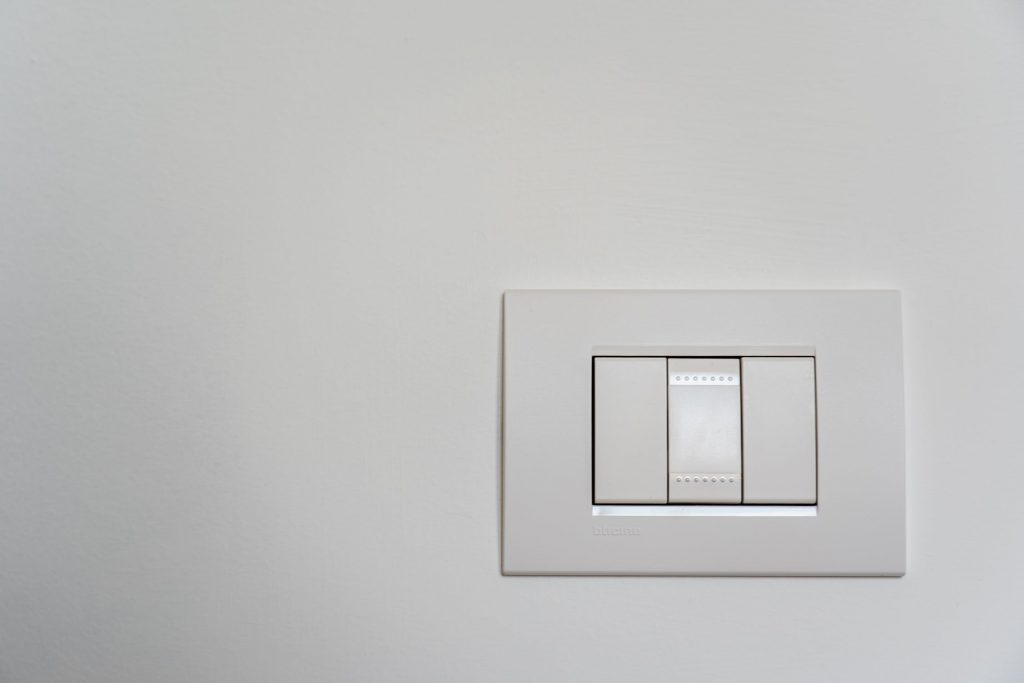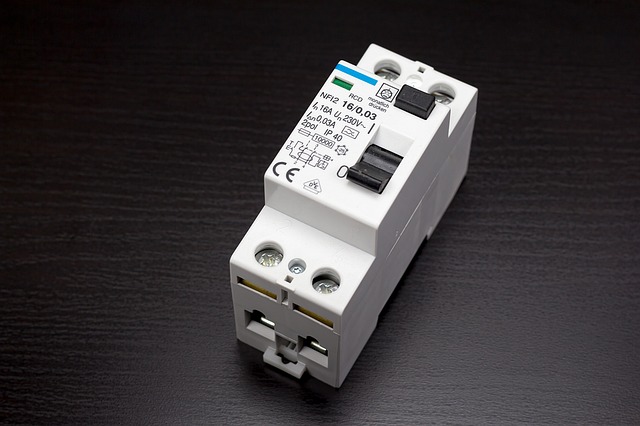Electrical switches transfer or interrupt the electric current in an electric power system. The mechanism of the control can take many forms. For example, when powering a light from a wall outlet, the simplest form would be to toggle a mechanical switch at the socket where the light was plugged in or hardwired into place. This type of primary manual switch may only have 2 points that allow for connection and disconnecting the two wires, which completes an electrical circuit enabling electricity to flow.
 The circuit can be opened by breaking the connection between the wires or interrupting the current at some point before it enters the light fixture. Activating a switch in this fashion does not change the system’s state. Instead, it merely interrupts an ongoing flow of electrons through an established pathway to enable new connections.
The circuit can be opened by breaking the connection between the wires or interrupting the current at some point before it enters the light fixture. Activating a switch in this fashion does not change the system’s state. Instead, it merely interrupts an ongoing flow of electrons through an established pathway to enable new connections.
 Breakers are rated for different amounts of current and are chosen for the specific load they will be carrying. A 20 amp breaker, for example, is designed to interrupt a current flow of up to 20 amps without damage. Breakers can also be classified as single-pole or double-pole. A single-pole breaker interrupts the current in one wire only, while a double-pole breaker interrupts the draft in two wires simultaneously. This is important because if two single-pole breakers are used in parallel, they will not interrupt the current in the circuit. Only a double-pole breaker will do that.
Breakers are rated for different amounts of current and are chosen for the specific load they will be carrying. A 20 amp breaker, for example, is designed to interrupt a current flow of up to 20 amps without damage. Breakers can also be classified as single-pole or double-pole. A single-pole breaker interrupts the current in one wire only, while a double-pole breaker interrupts the draft in two wires simultaneously. This is important because if two single-pole breakers are used in parallel, they will not interrupt the current in the circuit. Only a double-pole breaker will do that.
 The circuit can be opened by breaking the connection between the wires or interrupting the current at some point before it enters the light fixture. Activating a switch in this fashion does not change the system’s state. Instead, it merely interrupts an ongoing flow of electrons through an established pathway to enable new connections.
The circuit can be opened by breaking the connection between the wires or interrupting the current at some point before it enters the light fixture. Activating a switch in this fashion does not change the system’s state. Instead, it merely interrupts an ongoing flow of electrons through an established pathway to enable new connections.
Types of Electrical Switches
Different electrical switches enable the connection and disconnection of circuits in many different ways. The type of switch is chosen for specific applications depending on the voltage, current, resistance, durability requirements, among other things. Here are some of them and their importance:Ground Switch:
Ground switches are used to create a connection between the ground wire and the neutral wire in systems with more than one conductor. The ground switch does this by creating continuity between both wires. This is good for ensuring you do not get an electric shock if you touch any exposed metal part of the electrical system. An important safety feature on some devices like refrigerators, freezers, dishwashers, water heaters, and other gas or electric appliances that may be installed indoors is that they have a special switch to the ground before terminating at another appliance’s enclosure. This device is beneficial during installation, service work, or repair because it helps locate grounded objects near live parts, which helps protect against unexpected shocks from defective insulation, which would otherwise not be apparent.Miniature Circuit Breaker (MCB):
A miniature circuit breaker is similar to a standard household circuit breaker. Only it is smaller in size. This makes them ideal for use with small appliances that have little or no built-in protection against short circuits. This includes things like computers, stereos, televisions, and any other device where the house’s wiring will be used instead of an internal fuse. If the appliance experiences too great a current flow, it will trip open, which shuts off all power to protect itself from damage. MCBs are also available in manual or automatic reset models, depending on how quickly you want to get your equipment back up and running after it has trippedCircuit Breaker:
A circuit breaker is a switch that interrupts the flow of current in an electric circuit when it exceeds a safe level. This is usually done by thermal expansion or electromagnetism. When the current reaches the preset limit, the breaker trips open and stops the current flow. Breakers are rated for different amounts of current and are chosen for the specific load they will be carrying. A 20 amp breaker, for example, is designed to interrupt a current flow of up to 20 amps without damage. Breakers can also be classified as single-pole or double-pole. A single-pole breaker interrupts the current in one wire only, while a double-pole breaker interrupts the draft in two wires simultaneously. This is important because if two single-pole breakers are used in parallel, they will not interrupt the current in the circuit. Only a double-pole breaker will do that.
Breakers are rated for different amounts of current and are chosen for the specific load they will be carrying. A 20 amp breaker, for example, is designed to interrupt a current flow of up to 20 amps without damage. Breakers can also be classified as single-pole or double-pole. A single-pole breaker interrupts the current in one wire only, while a double-pole breaker interrupts the draft in two wires simultaneously. This is important because if two single-pole breakers are used in parallel, they will not interrupt the current in the circuit. Only a double-pole breaker will do that.











